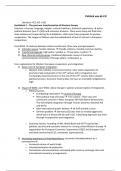Samenvatting
Samenvatting Politiek van de Europese Unie 2022/2023 Universiteit Leiden
- Vak
- Instelling
- Boek
Dit is een samenvatting van de hoorcolleges en de verplichte literatuur die horen bij het vak Politiek van de Europese Unie van de studie Politiciologie / Internationale Politiek aan de Universiteit Leiden. Het bevat alle tekst van de powerpoints, belangrijke aantekeningen en opmerkingen en de alle...
[Meer zien]




